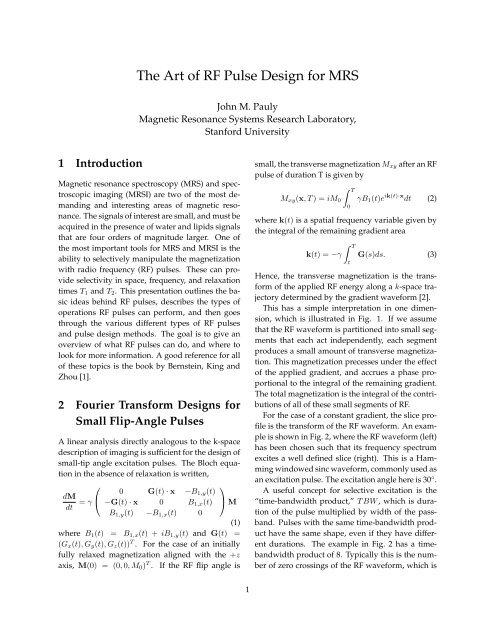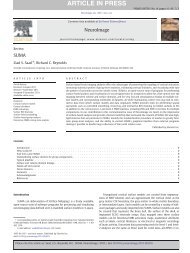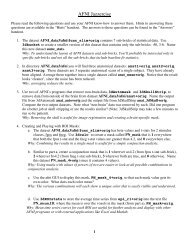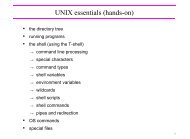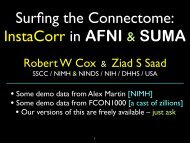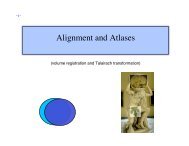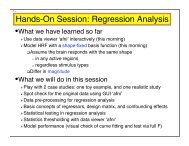The Art of RF Pulse Design for MRS
The Art of RF Pulse Design for MRS
The Art of RF Pulse Design for MRS
Create successful ePaper yourself
Turn your PDF publications into a flip-book with our unique Google optimized e-Paper software.
<strong>The</strong> <strong>Art</strong> <strong>of</strong> <strong>RF</strong> <strong>Pulse</strong> <strong>Design</strong> <strong>for</strong> <strong>MRS</strong>John M. PaulyMagnetic Resonance Systems Research Laboratory,Stan<strong>for</strong>d University1 IntroductionMagnetic resonance spectroscopy (<strong>MRS</strong>) and spectroscopicimaging (<strong>MRS</strong>I) are two <strong>of</strong> the most demandingand interesting areas <strong>of</strong> magnetic resonance.<strong>The</strong> signals <strong>of</strong> interest are small, and must beacquired in the presence <strong>of</strong> water and lipids signalsthat are four orders <strong>of</strong> magnitude larger. One <strong>of</strong>the most important tools <strong>for</strong> <strong>MRS</strong> and <strong>MRS</strong>I is theability to selectively manipulate the magnetizationwith radio frequency (<strong>RF</strong>) pulses. <strong>The</strong>se can provideselectivity in space, frequency, and relaxationtimes T 1 and T 2 . This presentation outlines the basicideas behind <strong>RF</strong> pulses, describes the types <strong>of</strong>operations <strong>RF</strong> pulses can per<strong>for</strong>m, and then goesthrough the various different types <strong>of</strong> <strong>RF</strong> pulsesand pulse design methods. <strong>The</strong> goal is to give anoverview <strong>of</strong> what <strong>RF</strong> pulses can do, and where tolook <strong>for</strong> more in<strong>for</strong>mation. A good reference <strong>for</strong> all<strong>of</strong> these topics is the book by Bernstein, King andZhou [1].2 Fourier Trans<strong>for</strong>m <strong>Design</strong>s <strong>for</strong>Small Flip-Angle <strong>Pulse</strong>sA linear analysis directly analogous to the k-spacedescription <strong>of</strong> imaging is sufficient <strong>for</strong> the design <strong>of</strong>small-tip angle excitation pulses. <strong>The</strong> Bloch equationin the absence <strong>of</strong> relaxation is written,dMdt⎛= γ ⎝0 G(t) · x −B 1,y (t)−G(t) · x 0 B 1,x (t)B 1,y (t) −B 1,x (t) 0⎞⎠ M(1)where B 1 (t) = B 1,x (t) + iB 1,y (t) and G(t) =(G x (t), G y (t), G z (t)) T . For the case <strong>of</strong> an initiallyfully relaxed magnetization aligned with the +zaxis, M(0) = (0, 0, M 0 ) T . If the <strong>RF</strong> flip angle issmall, the transverse magnetization M xy after an <strong>RF</strong>pulse <strong>of</strong> duration T is given by∫ TM xy (x, T ) = iM 0 γB 1 (t)e ik(t)·x dt (2)where k(t) is a spatial frequency variable given bythe integral <strong>of</strong> the remaining gradient area0∫ Tk(t) = −γ G(s)ds. (3)tHence, the transverse magnetization is the trans<strong>for</strong>m<strong>of</strong> the applied <strong>RF</strong> energy along a k-space trajectorydetermined by the gradient wave<strong>for</strong>m [2].This has a simple interpretation in one dimension,which is illustrated in Fig. 1. If we assumethat the <strong>RF</strong> wave<strong>for</strong>m is partitioned into small segmentsthat each act independently, each segmentproduces a small amount <strong>of</strong> transverse magnetization.This magnetization precesses under the effect<strong>of</strong> the applied gradient, and accrues a phase proportionalto the integral <strong>of</strong> the remaining gradient.<strong>The</strong> total magnetization is the integral <strong>of</strong> the contributions<strong>of</strong> all <strong>of</strong> these small segments <strong>of</strong> <strong>RF</strong>.For the case <strong>of</strong> a constant gradient, the slice pr<strong>of</strong>ileis the trans<strong>for</strong>m <strong>of</strong> the <strong>RF</strong> wave<strong>for</strong>m. An exampleis shown in Fig. 2, where the <strong>RF</strong> wave<strong>for</strong>m (left)has been chosen such that its frequency spectrumexcites a well defined slice (right). This is a Hammingwindowed sinc wave<strong>for</strong>m, commonly used asan excitation pulse. <strong>The</strong> excitation angle here is 30 ◦ .A useful concept <strong>for</strong> selective excitation is the“time-bandwidth product,” T BW , which is duration<strong>of</strong> the pulse multiplied by width <strong>of</strong> the passband.<strong>Pulse</strong>s with the same time-bandwidth producthave the same shape, even if they have differentdurations. <strong>The</strong> example in Fig. 2 has a timebandwidthproduct <strong>of</strong> 8. Typically this is the number<strong>of</strong> zero crossings <strong>of</strong> the <strong>RF</strong> wave<strong>for</strong>m, which is1
<strong>RF</strong>Gγ B (t) dt 1Figure 1: Small-excitation approximation. Each incrementalsegment <strong>of</strong> the <strong>RF</strong>, γB 1(t)dt, produces transversemagnetization independently. <strong>The</strong>se then precess underthe influence <strong>of</strong> the remaining gradient. <strong>The</strong> integratedremaining gradient is k(t), so the accumulated phaseshift is e ik(t)·x . <strong>The</strong> slice pr<strong>of</strong>ile expression in Eq. 2 integratesover all <strong>of</strong> the incremental segments.<strong>RF</strong> <strong>Pulse</strong>B (t)1FourierTrans<strong>for</strong>mM xk(t)M ySlice Pr<strong>of</strong>ileFigure 2: A small-excitation <strong>RF</strong> pulse (left) and slice pr<strong>of</strong>ile(right).also 8 <strong>for</strong> this example. With a T BW = 8, a 4 mspulse has a bandwidth <strong>of</strong> 8/4 = 2 kHz. With a 1G/cm gradient, or 4.257 kHz/cm, this is a little lessthan a 5 mm slice.3 Large Flip Angle <strong>Pulse</strong>s<strong>RF</strong> pulses designed using linear Fourier trans<strong>for</strong>mdesigns work poorly <strong>for</strong> large-flip-angle inversionand spin-echo pulses. However, we can representthe desired rotation by two complex coefficients,called spinor representation. <strong>The</strong> Shinnar-Le Roux(SLR) trans<strong>for</strong>m invertably relates the <strong>RF</strong> pulse tothe magnetization pr<strong>of</strong>ile. We can then use Fouriertrans<strong>for</strong>ms to design the spinor slice pr<strong>of</strong>iles, andthe inverse SLR trans<strong>for</strong>m to solve <strong>for</strong> the corresponding<strong>RF</strong> pulse. Hence, the small-tip-angle designmethods, plus the inverse SLR trans<strong>for</strong>m, allowthe exact design <strong>of</strong> large-flip-angle pulses.3.1 SpinorsMethods based on calculating the final magnetizationproduce by an <strong>RF</strong> pulse are are limited, sincethis is insufficient to fully characterize the rotationproduced by the pulse. A more convenient approachuses the spinor representation <strong>of</strong> rotations,which only requires two complex numbers to completelycharacterize the rotation. Given the spinor,the effect <strong>of</strong> the <strong>RF</strong> pulse on any initial magnetizationcan be calculated.<strong>The</strong> Bloch equation in the absence <strong>of</strong> relaxationreduces to a sequence <strong>of</strong> rotations. Although wecan solve <strong>for</strong> these rotations by multiplying 3x3 matrices,there is a much simpler representation using2x2 complex matrices and spinors [3]. A rotation byan angle φ about an axis n = (n x , n y , n z ) T is representedby the matrix( ) α −β∗Q =β α ∗ (4)whereα = cos(φ/2) − i n z sin(φ/2) (5)β = −i (n x + i n y ) sin(φ/2). (6)<strong>The</strong>se satisfy the constraintαα ∗ + ββ ∗ = 1. (7)Note that the rotation angle appears as a half-anglein Eq. 6. <strong>The</strong> effect <strong>of</strong> a sequence <strong>of</strong> rotations is computedby multiplying out the 2x2 complex matrices.Note that the matrix is completely determined bythe first column (α, β) T , so that a pair <strong>of</strong> complexnumbers is all that is needed to represent a rotation.Once the rotation produced by an <strong>RF</strong> pulse hasbeen computed, we would like to know what effectit has given some initial magnetization. Althoughthe derivation <strong>of</strong> these relationships is complex, theresults are very simple. For an excitation pulse,given an initial magnetization <strong>of</strong> M = (0, 0, M 0 ) T ,we would like to know the transverse magnetization.This is given byM + xy = 2α ∗ βM 0 . (8)For an inversion or saturation pulse, the initial magnetizationis the same, but we are concerned withthe longitudinal magnetization. This is given byM + z = (1 − 2ββ ∗ )M 0 . (9)
Spin-echo pulses produce two terms, the spin echoand the unrefocused magnetization which is usuallysuppressed with dephasing gradients. If weassume the initial magnetization is along +y, thespin-echo component isa)sin(φ/2)1Desired βPr<strong>of</strong>ileM + xy = i β 2 M 0 . (10)Given α, β, and the initial magnetization, it is veryeasy to compute the final magnetization <strong>for</strong> mosttypes <strong>of</strong> <strong>RF</strong> pulses.b)0B (z) Nx3.2 <strong>The</strong> Shinnar-Le Roux AlgorithmRemarkably, given a representation <strong>of</strong> a slice pr<strong>of</strong>ilein an appropriate <strong>for</strong>m, it is also easy to solve <strong>for</strong> the<strong>RF</strong> pulse that will produce it. <strong>The</strong> Shinnar-Le RouxAlgorithm approximates a continuous <strong>RF</strong> pulse as asequence <strong>of</strong> impulsive <strong>RF</strong> pulses interspersed withfree precession intervals. This is the very importanthard-pulse approximation [4–10]. It results in thespinor representation <strong>of</strong> the slice pr<strong>of</strong>ile to be givenby A N (z) and B N (z), two N th order polynomials inz = e iγGx∆t where ∆t is the sampling time.<strong>The</strong> significance <strong>of</strong> this representation is that itis invertible. This inversion procedure can be usedto design <strong>RF</strong> pulses by designing the A N (z) andB N (z). <strong>The</strong> two polynomials must satisfy the amplitudeconstraints implicit in Eqs. 6 and 7. FromEq. 6 the function B N (z) should be chosen to approximatethe sine <strong>of</strong> half the desired rotation angle,with a constant phase determined by the desiredrotation axis. <strong>The</strong> magnitude <strong>of</strong> A N (z) is determinedby the magnitude constraint Eq. 7. As isshown in [10], a minimum power solution uniquelydetermines A N (z). Once A N (z) has been computed,the two polynomials are processed using theinversion procedure to produce the <strong>RF</strong> wave<strong>for</strong>m.This design procedure is the Shinnar-Le Roux algorithm.A similar approach based on rational polynomialrepresentation <strong>of</strong> the spinors can also beused [11, 12].An example <strong>of</strong> this method is shown in Fig. 3,which demonstrates the design <strong>of</strong> a spin-echopulse. We start by choosing a B N (z) that approximatesthe desired pr<strong>of</strong>ile. This can be just aboutany function that could be used as a lowpass digitalfilter. In this example we use the same Hammingwindowed sinc <strong>for</strong> Fig. 2, which is sometimes itselfused as a spin-echo pulse. From Eq. 6 B N (z) mustc)d)B1(t)1Mxy0t<strong>RF</strong> <strong>Pulse</strong>tSpin-EchoPr<strong>of</strong>ileFigure 3: Illustration <strong>of</strong> the design process in the SLR algorithm.In (a) the pr<strong>of</strong>ile <strong>of</strong> B N (z) is chosen and scaledto produce the right flip angle. <strong>The</strong> trans<strong>for</strong>m <strong>of</strong> this pr<strong>of</strong>ileis the B N (z) polynomial (b). <strong>The</strong> inverse SLR trans<strong>for</strong>mSLR −1 (B N (z)) produces the spin-echo <strong>RF</strong> pulse(c). <strong>The</strong> pr<strong>of</strong>ile <strong>of</strong> the refocused magnetization is shownin (d).be scaled so that the passband has an amplitude <strong>of</strong>sin φ/2 = sin π/2 = 1. This is plotted in Fig. 3. <strong>The</strong>A N (z) polynomial is then computed by the magnitudeconstraint, Eq. 6, and the minimum powercriteria. <strong>The</strong> <strong>RF</strong> pulse is then computed using theSLR inversion procedure. <strong>The</strong> resulting <strong>RF</strong> pulseand spin-echo pr<strong>of</strong>ile are also shown in Fig. 3c andd.Although this procedure may appear complex, itis actually very simple. <strong>The</strong> slice pr<strong>of</strong>ile is determinedby B N (z), which is designed as <strong>RF</strong> pulsesthemselves have traditionally been designed, usingFourier trans<strong>for</strong>m arguments. <strong>The</strong> flip angle is determinedby the scaling <strong>of</strong> B N (z). <strong>The</strong> rest <strong>of</strong> thex
procedure is deterministic, and can be considered ablack box. For convince, we’ll denote this black boxas the “inverse SLR trans<strong>for</strong>m”,a) b)1B (t) 1B 1 (t) = SLR −1 (B N (z)). (11)t-1M zx4 One Dimensional <strong>Pulse</strong>sA wide variety <strong>of</strong> types <strong>of</strong> <strong>RF</strong> pulses can be designedby using different initial B N (z) polynomials.<strong>The</strong> main considerations are what the pulse will beused <strong>for</strong>, and whether the slice pr<strong>of</strong>ile phase can beexploited.4.1 Linear-Phase <strong>Pulse</strong>sSlice-selective excitation pulses and spin-echopulses have maximum signal if the phase across theslice is linear. A linear-phase excitation pulse is perfectlyrefocused with a gradient reversal. A linearphase<strong>RF</strong> pulse is produced by starting with a linearphase B N (z). <strong>The</strong>se are hermitian symmetric aboutthe midpoint, as in Fig. 3.<strong>The</strong>re are two costs <strong>for</strong> linear phase. One is thata linear-phase pulse also maximizes the peak <strong>RF</strong>power. Another is that the slice pr<strong>of</strong>ile is not as selectiveas minimum/maximum phase or non-linearphase pulses can be.4.2 Minimum/Maximum-Phase <strong>Pulse</strong>sFor other types <strong>of</strong> pulses, the phase <strong>of</strong> the pr<strong>of</strong>ileis not an issue. This is true <strong>of</strong> inversion pulses andsaturation pulses, where any transverse magnetizationis generally suppressed with a dephasing gradient.In this case, we can improve the selectivity<strong>of</strong> the pr<strong>of</strong>ile by starting with a minimum or maximumphase design. This can be almost twice asselective as a linear-phase pulse <strong>for</strong> the same duration.A minimum phase pulse has most <strong>of</strong> the <strong>RF</strong> energyat the end <strong>of</strong> the pulse. A maximum-phasepulse is a minimum-phase pulse played in reverseorder. An example <strong>of</strong> a minimum-phase inversionpulse is shown in Fig. 4.Figure 4: Minimum-phase inversion pulse (left) and inversionpr<strong>of</strong>ile (right).4.3 Nonlinear-Phase <strong>Pulse</strong>sWhile minimum and maximum phase pulses havesharper slice pr<strong>of</strong>iles than linear-phase pulses, theyrequire very close to the same peak power. Peakpower is <strong>of</strong>ten the primary practical concern whendesigning pulses. Lower peak power can <strong>of</strong>ten beobtained by using a non-linear phase <strong>RF</strong> pulse [13,14]. <strong>The</strong>se can be designed by starting with a minimumphase B N (z). If this has a time-bandwidthproduct <strong>of</strong> M, there are 2 M possible phase pr<strong>of</strong>ilesthat have an identical magnitude pr<strong>of</strong>ile. <strong>The</strong>secan be searched to optimize a particular parameter,such as peak <strong>RF</strong> power. An example <strong>of</strong> an inversionpulse designed with this approach is shown inFig. 5, along with the minimum phase pulse withthe identical pr<strong>of</strong>ile. In this case the peak amplitudehas been reduced to 56%. Note that the integratedpower remains the same. <strong>The</strong> use <strong>of</strong> nonlinearphase simply distributes this power moreuni<strong>for</strong>mly along the length <strong>of</strong> the pulse.For higher time-bandwidth pulses, exhaustivesearches become impractical. A preferred approachis to choose a target quadratic phase pr<strong>of</strong>ile, andconstruct B N (z) so as to closely approximate thispr<strong>of</strong>ile. This is the approach used by Le Roux inthe design <strong>of</strong> his Very Selective Saturation (VSS)pulses [15, 16].4.4 Adiabatic <strong>Pulse</strong>sAnother class <strong>of</strong> non-linear phase <strong>RF</strong> pulses areadiabatic pulses, which are designed from a completelydifferent perspective. <strong>The</strong> idea here is thatthe frequency and amplitude <strong>of</strong> the <strong>RF</strong> pulse aresmoothly swept, to keep the magnetization eitheraligned with or orthogonal to the effective <strong>RF</strong> vector.<strong>The</strong> most important example is the hyperbolic
a)0.25k ya) b)k yB1(t). Gauss0.02 4 6t,msk xyk xb)B1(t). Gauss0.250.02 4 6t,msFigure 5: Comparison <strong>of</strong> a minimum phase and an optimizednon-linear phase inversion pulses. Both pulseshave identical inversion pr<strong>of</strong>iles. <strong>The</strong> optimized nonlinearphase pulse has 56% <strong>of</strong> the amplitude <strong>of</strong> the minimumphase pulse, or 31% <strong>of</strong> the peak power. <strong>The</strong> integratedpower <strong>of</strong> the two pulses is identical.Amplitude, GMz0.20.150.10.050!0.05!0.1!0.15!10 !8 !6 !4 !2 0 2 4 6 8 10Time, msMz10.510.50!0.50!0.5B 1 (t) = A 0 sech(βt)e −iµβtanh(βt)tβ = 800 rad/s; µ = 4.9Inversion Pr<strong>of</strong>ile!1!2 !1.5 !1 !0.5 0 0.5 1 1.5 2!10.45 0.5 0.55Frequency, kHz0.6 0.65 0.7 0.75 0.8 0.85Frequency, kHzFigure 6: A hyperbolic secant <strong>RF</strong> pulse (top) and it’s inversionpr<strong>of</strong>ile (bottom). <strong>The</strong> hyperbolic secant is an adiabaticpulse, that produces a high fidelty inversion pr<strong>of</strong>ile<strong>for</strong> any <strong>RF</strong> level above a given threshold.secant pulse, shown in Fig. 6. An adiabatic pulseper<strong>for</strong>ms an inversion <strong>for</strong> any <strong>RF</strong> level above agiven threshold. <strong>The</strong>se are very useful when accurateinversions are required, or when the homogeneity<strong>of</strong> the <strong>RF</strong> field is inadequate. Using combinations<strong>of</strong> half sweeps, adiabatic pulses can be designed<strong>for</strong> any flip angle [1].Figure 7: A spiral k-space trajectory (a) and an EPI trajectory(b). As a direct parallel to the imaging case, either<strong>of</strong> these can be used as the basis <strong>of</strong> a 2D <strong>RF</strong> pulse. Manyother trajectories are also possible.5 Multidimensional SelectiveExcitation<strong>RF</strong> pulses that are selective in multiple dimensionscan also be designed. In the small-tip-angle caseFourier trans<strong>for</strong>m arguments can be used, and theresult is directly analogous to the image reconstructionproblem <strong>for</strong> an arbitrary k-space trajectory. Forthe large-tip-angle case, the issues are more complex.Fourier trans<strong>for</strong>m designs can still be usedif certain symmetry requirements are met. However,the important case <strong>of</strong> large-flip-angle spectralspatialpulses is a non-linear problem.5.1 Fourier Trans<strong>for</strong>m Multidimensional<strong>Pulse</strong>sFor non-constant gradients and in multiple dimensionsthe k-space velocity should be normalized∫ TγB 1 (t)M xy (x, T ) = iM eik(t)·x 0 |γG(t)|dt.0 |γG(t)|(12)<strong>The</strong> G(t) is chosen to trace out a pattern that uni<strong>for</strong>mlycovers a region <strong>of</strong> k-space [2]. Two commonexamples are shown in Fig. 7. As in imaging, therate at which this pattern is traced out varies dueto the limitations <strong>of</strong> the gradient system hardware.As a result, the <strong>RF</strong> wave<strong>for</strong>m that should be appliedis the sampled trans<strong>for</strong>m <strong>of</strong> the desired pr<strong>of</strong>ile,compensated by the k-space velocity. An additionalcompensation term is required if the k-spacetrajectory is non-uni<strong>for</strong>m [17,18], just as in imaging.<strong>The</strong> excited volume can be shifted to any positionx 0 by modulating the <strong>RF</strong> wave<strong>for</strong>m with e −ik(t)·x0 .Effectively, this keeps the point x 0 exactly on reso-
a)b)c)d)y<strong>RF</strong>B1(t)/|γG(t)|M yGx, GyFigure 8: 2D <strong>RF</strong> pulse (a), gradients (b), k-space weighting(c), and excitation pr<strong>of</strong>ile (d).nance as the gradient wave<strong>for</strong>m is played out.An example multidimensional <strong>RF</strong> pulse is shownin Fig. 8. This is a 2D selective excitation pulsebased on a spiral gradient. <strong>The</strong> gradient spirals into the center so that no refocusing lobe is required.This pulse excites a cylinder, limited in x − y plane,and extending in z.This type <strong>of</strong> pulse is <strong>of</strong>ten used to restrict excitationto a single column or “pencil” to allow tracking<strong>of</strong> very rapid motion, such as in MR m-mode[19–22] or MR Doppler [23–25]. It is also frequentlyused <strong>for</strong> navigator acquisitions [26, 27].xk yttk x5.2 Echo-Planar and Spectral-Spatial<strong>Pulse</strong>sNon-linear multidimensional pulses can be designedby using the SLR algorithm in one dimension,and linear designs in the remaining dimensions.This includes the important special case <strong>of</strong>spectral-spatial spin-echo pulses.<strong>The</strong> second example k-space trajectory in Fig. 7 isEPI. This can be used as the basis <strong>of</strong> a 2D spatial excitation<strong>RF</strong> pulse, using exactly the same approachas <strong>for</strong> the spiral pulse shown in Fig. 8. This has beenused as an excitation pulse <strong>for</strong> 2D saturation [28]and to limit the FOV <strong>for</strong> fast imaging.An important extension <strong>of</strong> echo-planar based designsis the spectral-spatial pulse [29] which is simultaneouslyselective in both space and frequency.Spectral-spatial pulses are used <strong>for</strong> lipid suppression<strong>for</strong> fast EPI or spiral imaging, where lipidswould otherwise produce image artifacts [30]. Inaddition, they can be used in fast spin-echo imagingto eliminate the bright fat effect [31]. Finally,they can be used <strong>for</strong> water suppression in spectroscopicimaging [32, 33].A spectral-spatial pulse is based on a conventionalecho-planar k-space trajectory. For a 2Dspatial pulse the constant gradient in the “phaseencode”direction establishes a linear distribution<strong>of</strong> frequencies, and the <strong>RF</strong> pulse selects a range <strong>of</strong>these frequencies. For a spectral-spatial pulse, weuse the same <strong>RF</strong> pulse, but eliminate the constantgradient. This leaves us with a pulse that is frequencyselective to the naturally occuring sources<strong>of</strong> frequency shifts such as chemical shift and susceptibilityshifts.While spectral-spatial pulses can be designed usingthe small-excitation approximation, as in Fig. 8,this approach degrades as the flip angle increases.For spin-echo or inversion pulses, the nonlinearity<strong>of</strong> the Bloch equation must be considered. An effectiveapproach is to use an SLR design in the spectraldimension, and the small-rotation approximationin the spatial domain [34]. Spin-echo pulsesdesigned with this approach can produce excellentwater suppression <strong>for</strong> <strong>MRS</strong>I experiments [32–34].Figure 9 is a spin-echo pulse designed with thisapproach. Another approach is a full 2D SLR design[35]. By replacing the 1D subpulses with 2Dspirals, a 3D pulse, or a 2D spatial, 1D spectral pulse
can also be produced [36].Spectral-spatial pulses have some interestingproperties. <strong>The</strong>y don’t exhibit displacement withfrequency <strong>of</strong>fset [31]. <strong>The</strong> spectral-spatial pulsespatial pr<strong>of</strong>ile is only perfect exactly on resonance,but this point can be shifted in the design to improveper<strong>for</strong>mance at any particular point. This isuseful <strong>for</strong> improving the depth <strong>of</strong> a stopband [34] oreliminating an N/2 sidelobe [37]. In addition, simplifieddesigns can be based on conventional sliceselective pulses with trapezoidal gradients [38]. Byusing only alternate gradient lobes, the flow per<strong>for</strong>manceis also improved.a)b)k zB (t) 1tG(t)tk = t ωReferencesc)d)zk zγB (t)/|γG(t)|1|M |xy[1] M. Bernstein, K. King, and J. Zhou. Handbook <strong>of</strong> MRI<strong>Pulse</strong> Sequences. Elsevier Press, 2004.[2] J.M. Pauly, D.G. Nishimura, and A. Macovski. Ak-space analysis <strong>of</strong> small tip excitation. J. Magn. Reson.,81:43–56, Jan 1989.[3] E. T. Jaynes. Matrix treatment <strong>of</strong> nuclear induction.Phys Rev, 98(4):1099–1105, May 1955.[4] P. Le Roux. French patent 8610179, 1986.[5] P. Le Roux. Exact synthesis <strong>of</strong> radi<strong>of</strong>requency wave<strong>for</strong>ms.In Proc. Seventh SMRM, page 1049, August1988.[6] M. Shinnar, S. Eleff, H. Subramanian, and J.S. Leigh.<strong>The</strong> synthesis <strong>of</strong> pulse sequences yielding arbitrarymagnetization vectors. Magn. Reson. Med., 12:74–80,Oct 1989.[7] M. Shinnar, L. Bolinger, and J.S. Leigh. <strong>The</strong> use <strong>of</strong> finiteimpulse response filters in pulse design. Magn.Reson. Med., 12:75–87, Oct 1989.[8] M. Shinnar, L. Bolinger, and J.S. Leigh. <strong>The</strong> synthesis<strong>of</strong> s<strong>of</strong>t pulses with a specified frequency response.Magn. Reson. Med., 12:88–92, Oct 1989.[9] M. Shinnar and J.S. Leigh. <strong>The</strong> application <strong>of</strong>spinors to pulse synthesis and analysis. Magn. Reson.Med., 12:93–98, Oct 1989.[10] J.M. Pauly, P. Le Roux, D.G. Nishimura, and A. Macovski.Parameter relations <strong>for</strong> the Shinnar-Le Roux<strong>RF</strong> pulse design algorithm. IEEE Trans. on Med.Imag., 10(1):53–65, 1991.[11] C.L. Epstein. Minimum energy pulse synthesis viathe inverse scattering trans<strong>for</strong>m. J. Magn. Reson.,167(2):185–210, Apr 2004.[12] J. Magland and C.L. Epstein. Practical pulse synthesisvia the discrete inverse scattering trans<strong>for</strong>m.J. Magn. Reson., 172(1):63–78, Jan 2005.[13] M. Shinnar. Reduced power selective excitation rak= t ωFigure 9: Spectral-Spatial spin-echo <strong>RF</strong> pulse and gradient,k-space trajectory (b), k-space weighting (c), andspin-echo pr<strong>of</strong>ile (d).dio frequency pulses. Magn Reson Med, 32(5):658–60, 1994.[14] S. Pickup and X. Ding. <strong>Pulse</strong>s with fixed magnitudeand variable phase response pr<strong>of</strong>iles. Magn ResonMed, 33(5):648–55, 1995.[15] P. Le Roux, R. J. Gilles, G. C. McKinnon, and P. G.Carlier. Optimized outer volume suppression <strong>for</strong>single-shot fast spin-echo cardiac imaging. J MagnReson Imaging, 8(5):1022–32, 1998.[16] T. K. Tran, D. B. Vigneron, N. Sailasuta, J. Tropp,P. Le Roux, J. Kurhanewicz, S. Nelson, and R. Hurd.ω
Very selective suppression pulses <strong>for</strong> clinical <strong>MRS</strong>Istudies <strong>of</strong> brain and prostate cancer. Magn ResonMed, 43(1):23–33, 2000.[17] C.J. Hardy, H.E. Cline, and P.A. Bottomley. Correcting<strong>for</strong> nonuni<strong>for</strong>m k-space sampling in twodimensionalNMR selective excitation. J. Magn. Reson.,87:639–645, 1990.[18] C. J. Hardy and P. A. Bottomley. 31P spectroscopiclocalization using pinwheel NMR excitation pulses.Magn Reson Med, 17(2):315–27, 1991.[19] H. E. Cline, C. J. Hardy, and J. D. Pearlman. FastMR cardiac pr<strong>of</strong>iling with two-dimensional selectivepulses. Magn Reson Med, 17(2):390–401, 1991.[20] J. D. Pearlman, C. J. Hardy, and H. E. Cline. ContinualNMR cardiography without gating: M-modeMR imaging. Radiology, 175(2):369–73, 1990.[21] C. J. Hardy, B. D. Bolster, E. R. McVeigh, I. E.Iben, and E. A. Zerhouni. Pencil excitation withinterleaved fourier velocity encoding: NMR measurement<strong>of</strong> aortic distensibility. Magn Reson Med,35(6):814–9, 1996.[22] K. Butts, N. J. Hangiandreou, and S. J. Riederer.Phase velocity mapping with a real time line scantechnique. Magn Reson Med, 29(1):134–8, 1993.[23] P. Irarrazabal, B. S. Hu, J. M. Pauly, and D. G.Nishimura. Spatially resolved and localized realtimevelocity distribution. Magn Reson Med,30(2):207–12, 1993.[24] B. S. Hu, J. M. Pauly, and D. G. Nishimura. Localizedreal-time velocity spectra determination. MagnReson Med, 30(3):393–8, 1993.[25] G. T. Luk Pat, J. M. Pauly, B. S. Hu, and D. G.Nishimura. One-shot spatially resolved velocityimaging. Magn Reson Med, 40(4):603–13, 1998.[26] Y.L. Liu, S.J. Riederer, P.J. Rossman, R.C. Grim, J.P.Debbins, and R.L. Ehman. A monitoring, feedback,and triggering system <strong>for</strong> reproducible breath-holdMR imaging. Magn. Reson. Med., 30(4):507–11, 1993.[27] Y. Wang, P.J. Rossman, R.C. Grimm, S.J. Riederer,and R.L. Ehman. Navigator-echo-based real-timerespiratory gating and triggering <strong>for</strong> reduction <strong>of</strong>respiration effects in three-dimensional coronaryMR angiography. Radiology, 198(1):55–60, 1996.[28] M. T. Alley, J. M. Pauly, F. G. Sommer, and N. J. Pelc.Angiographic imaging with 2d rf pulses. Magn ResonMed, 37(2):260–7, 1997.[29] C. H. Meyer, J. M. Pauly, A. Macovski, and D. G.Nishimura. Simultaneous spatial and spectral selectiveexcitation. Magn Reson Med, 15(2):287–304,1990.[30] C.H. Meyer, B.S. Hu, D.G. Nishimura, and A. Macovski.Fast spiral coronary artery imaging. Magn.Reson. Med., 28(2):202–213, December 1992.[31] W. Block, J. Pauly, A. Kerr, and D. Nishimura. Consistentfat suppression with compensated spectralspatialpulses. Magn Reson Med, 38(2):198–206, 1997.[32] D. Spielman, J. Pauly, A. Macovski, and D. Enzmann.Spectroscopic imaging with multidimensionalpulses <strong>for</strong> excitation: Simple. Magn ResonMed, 19(1):67–84, 1991.[33] J. Star-Lack, D. B. Vigneron, J. Pauly, J. Kurhanewicz,and S. J. Nelson. Improved solvent suppression andincreased spatial excitation bandwidths <strong>for</strong> threedimensionalPRESS CSI using phase-compensatingspectral/spatial spin-echo pulses. J Magn ResonImaging, 7(4):745–57, 1997.[34] J. Pauly, D. Spielman, and A. Macovski. Echo-planarspin-echo and inversion pulses. Magn Reson Med,29(6):776–82, 1993.[35] M. H. Buonocore. A Shinnar-Le Roux algorithm <strong>for</strong>design <strong>of</strong> 2D and 3D spatially selective <strong>RF</strong> pulses. InProc. Tenth SMRI, in J. Magn. Reson. Imaging, number2P, page 145, Mar./Apr. 1992.[36] J. M. Pauly, B. S. Hu, S. J. Wang, D. G. Nishimura,and A. Macovski. A three-dimensional spin-echo orinversion pulse. Magn Reson Med, 29(1):2–6, 1993.[37] Y. Zur. <strong>Design</strong> <strong>of</strong> improved spectral-spatial pulses<strong>for</strong> routine clinical use. Magn Reson Med, 43(3):410–20, 2000.[38] F. Schick. Simultaneous highly selective MR waterand fat imaging using a simple new type <strong>of</strong> spectralspatialexcitation. Magn Reson Med, 40(2):194–202,1998.


